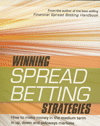

Winning Spread Betting Strategies

Malcolm Pryor
Reviewed by Eve Bolton
- Avoid
- Browse
- Buy
- Love
- Never Play Without It
Acclaimed author and certified financial technician Malcolm Pryor returns to the fore with indispensable strategies that can help anyone win at spread betting. The book not only outlines the key strategies for success, but also covers the psychological aspects of spread betting. Filled with illustrative charts, the book does assume some knowledge of the discipline. Nonetheless, Pryor does a fantastic job of explaining the pros, cons, and potential pitfalls associated with all his methods. While some readers might find that the author's approach requires patience, you'll be rewarded handsomely when you embrace his measured methods.
Author of 2007’s The Financial Spread Betting Handbook, Malcolm Pryor has returned with a new publication about the ins and outs of betting in “up, down and sideways markets”, Winning Spread Betting Strategies. Pryor’s second title, published by Harriman-House, indicates the differences between spread bettors and the “spread betting investor”. It is the analytic mind of the latter which Pryor delves into, showing throughout the text how the investor’s psychological mind-set differs from short-term bettors. Winning Spread Betting Strategies is not for those who believe betting success or failure can be judged within days, and it’s also not apt reading for spread bettors who wager purely for entertainment value. As Pryor notes:
There are two common misunderstandings about spread betting, one being that it is just gambling, the other that (it) is just for the short term...There are of course those who treat spread betting in much the same way as a trip to the casino or the race track, with, for the most part, similar results – but this book is not for them.
So, if Pryor’s book isn’t for those looking to make a fast buck, or emulate their success at the blackjack table through spread betting, just who is it aimed at? Well, if you’re looking for advice which you can follow, implement and customise, then Pryor’s book is for you. In Spread Betting Investor Strategies, Pryor outlines the Technical Tools he uses to analyse investments. However, all of Winning Spread Betting Strategies is a veritable delight for potential spread bettors looking for tools to help guide them towards success.
Pryor doesn’t force newcomers to the world of financial spread betting to plunge in at the deep end either. The book is split into two parts. The first discusses the psychology of the spread betting investor and the second half examines Pryor’s strategies. If this wasn’t enough, purchasing the book means you’re initiated into an online and offline world of market analysis. Pryor even has his own forum, www.spreadbettingcentral.co.uk, through which you can find advice and discuss how you’ve modified one of the book’s strategies. The author also lists the software he favours (ShareScope), and throughout the book you’re treated to real market and trade analysis, as well as helpful commentaries.
While Pryor insists throughout Winning Spread Betting Strategies that spread betting isn’t entertainment, but business, and in turn that his book should not be treated as the former, Pryor has such a clear cut and eloquent prose that it’s impossible not to enjoy his treatment of spread betting. Each section transparently lists the advantages, disadvantages, and technical challenges potential investors will face when they adopt one of Pryor’s strategies and guides the reader through examples of success and potential failure, at a consistent pace.
The only reason we believe this book merited 4 stars out of 5, instead of receiving the full accolade, is because Pryor’s two titles (The Financial Spread Betting Handbook and Winning Spread Betting Strategies) perhaps best work well as a package. Utilise these two publications alongside Pryor’s exhaustive internet resource and software tips and you’ll find the complete “spread betting investor” experience a well-rounded and authoritative introduction to the markets.
